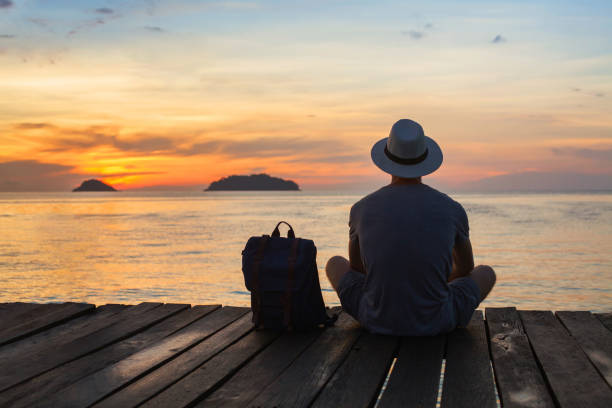
In today’s fast-paced world of travel, it’s easy to become consumed by the endless desire to check off every iconic landmark, snap the perfect photo for social media, or simply squeeze in as many activities as possible in the shortest amount of time. Our obsession with documenting our trips, ticking off must-see lists, and planning every minute of our vacations often leads us to overlook one of the most profound aspects of traveling: being truly present in the moment.
The idea of conceding to the moment—allowing ourselves to fully experience the here and now, without distractions, expectations, or pressures—may sound simple, but it holds a transformative power that many travelers miss. Whether it’s watching the sun set over the Grand Canyon, feeling the warmth of the sun on your skin as you sit quietly at a temple in Bali, or walking along a secluded beach without a care in the world, these are the moments that truly shape our travel memories.
In a world where every trip is meticulously planned and shared with an audience, the ability to simply concede and embrace the present moment is often the most rewarding part of a journey. It’s not about rushing through activities or collecting experiences like souvenirs. It’s about letting go of the need to control every aspect of the trip and allowing travel to unfold naturally.
This article explores the significance of conceding to the moment while traveling and the profound impact it can have on our overall experience, offering a deeper connection to the places we visit, the people we meet, and, most importantly, ourselves.
1. The Pressure of “Must-See” Lists: The Problem with Rushing Through Travel
For many, travel is synonymous with bucket lists. The “must-see” spots—the Eiffel Tower in Paris, the Great Wall of China, Machu Picchu in Peru—are ingrained in our minds as the pinnacle of travel experiences. There’s a sense of urgency to visit these famous sites, almost as if our trips are incomplete without them. We set up jam-packed itineraries to ensure we see it all. The pressure to experience everything can feel overwhelming, even before we leave for our destinations.

While visiting iconic locations can be exciting, it’s easy to lose sight of the richness of the travel experience when we’re constantly rushing from one destination to the next, with only brief moments to actually savor the sights. For instance, you might visit the Colosseum in Rome, snapping several photos in front of it, but how often do we actually take a moment to step back and appreciate the ancient structure in silence? How often do we truly allow ourselves to feel the history, the energy, and the weight of the place, without the need to move on to the next “highlight”?
When we approach travel this way, we’re often on autopilot, checking boxes rather than embracing the essence of the places we visit. We might arrive at the Grand Canyon and find ourselves more focused on getting the perfect photo to share with friends than actually soaking in the view of the immense, colorful chasm that stretches for miles. The desire to “capture” the moment can sometimes overpower the ability to actually experience it.
This is where conceding to the moment can offer a breakthrough. By allowing ourselves to slow down, put our phones away, and simply be in the space we occupy, we gain the opportunity to connect with the destination on a deeper level. It’s about letting go of the need for perfection, letting go of the checklist, and surrendering to the experience in front of us.
2. The Power of Now: What Happens When We Stop and Breathe?
The art of conceding to the present moment is simple but transformative. When we make a conscious effort to be present, we stop thinking about the next task on our to-do list or the next destination on our itinerary. We stop mentally rehearsing the conversation we plan to have with the bartender or the meal we want to try at the next restaurant. Instead, we focus on what’s right in front of us: the feeling of warm sand beneath our feet, the scent of fresh flowers in the air, the laughter of children playing, or the sounds of waves crashing against the shore.

By consciously choosing to be present, we tap into a deeper level of mindfulness that allows us to fully engage with our surroundings. When we visit places like Bali, for example, we might find ourselves sitting quietly at the Pura Besakih Temple, the largest and holiest temple in Bali. Instead of rushing through the temple complex to take as many photos as possible, conceding to the moment means sitting still and absorbing the beauty of the intricate stone carvings, the sound of temple bells in the distance, and the incense swirling in the air. We are no longer distracted by external factors or expectations; we are simply there, engaged in the present.
Travel can be a beautiful exercise in mindfulness. Conceding to the moment means letting go of distractions—whether it’s checking your phone or worrying about what’s next—and truly connecting with the sensory experience of the destination. This moment of stillness often reveals deeper layers of a place that go unnoticed in the rush to see and do more. By being present, you start to feel the pulse of the location in ways that go beyond the surface.
3. How to Concede to the Moment: Practical Tips for Being Present While Traveling
Embracing the present moment while traveling isn’t always easy. Our minds are often busy with thoughts about what to do next, where to go, or how to document the experience. However, conceding to the moment and being truly present takes practice. Here are a few practical ways to bring mindfulness into your travels:
a. Limit Digital Distractions:
One of the biggest barriers to being present while traveling is our reliance on digital devices. Our phones become a way to stay connected, capture memories, or navigate new places. But constantly checking emails, social media, or notifications pulls us out of the moment. Instead, set designated times for checking your phone, and during other moments, focus on immersing yourself in the present. Turn off notifications, and if you feel the urge to take photos, try to take one or two and then put your camera down. You’ll be surprised at how much more you notice when you’re not looking through a lens.

b. Slow Down:
The tendency to rush from one landmark to the next can lead to burnout and diminish the joy of discovery. Instead of cramming as many activities as possible into one day, slow down. Choose just one or two places to visit and take your time. If you’re in Paris, for example, don’t just snap a quick photo in front of the Louvre and rush on to the next museum. Allow yourself to sit on a bench and watch the world go by, or take an unhurried walk along the Seine. Let the rhythm of the city wash over you, and savor the experience at your own pace.
c. Focus on Your Senses:
Take time to tune into your senses while traveling. Pay attention to the textures around you, the sounds, the smells, and the colors that surround you. If you’re exploring a market in Marrakech, close your eyes for a moment and take in the fragrances of spices, fresh fruit, and flowers. Notice the warmth of the sun on your face and the sound of chatter around you. These sensory experiences are often the most meaningful parts of travel, yet they can easily be overlooked when we’re busy looking at our phones or worrying about what’s next.
d. Embrace Silence:
In a world full of noise, silence can be a rare gift. Whether you’re watching the sunset over the Grand Canyon or sitting by a quiet lake, take moments of stillness to just be. Find a peaceful spot to sit and reflect, allowing the natural world to fill your senses. Even in bustling cities, there are pockets of silence to be found—perhaps in a park, a quiet café, or a temple. These moments of solitude can help you reset, recharge, and gain a deeper appreciation for the place you’re in.
e. Practice Gratitude:
Sometimes, it’s easy to get caught up in our expectations or disappointments while traveling. Perhaps you’re frustrated by a delayed flight or the weather isn’t as perfect as you hoped. Practicing gratitude can help refocus your attention on the positives of the moment. Pause and reflect on what you’re thankful for—whether it’s the privilege of being in a new place, the people you’ve met, or simply the chance to relax. Gratitude can help you embrace the present moment, even in challenging circumstances.
4. The Rewards of Conceding to the Moment: Personal Growth and Transformation
There is a profound transformation that happens when we choose to concede to the moment. The act of being present can lead to deeper introspection and personal growth. Travel often challenges us to step outside our comfort zones, confront our fears, and open ourselves up to new experiences. By slowing down and being present, we allow ourselves the space to process these emotions and truly absorb the lessons that travel has to offer.
Some of the most profound moments of personal growth happen when we let go of our need for control and allow travel to unfold naturally. You may find that you learn more about yourself when you stop trying to fill every second with activity or when you choose to embrace silence in a new place. It’s in these moments of stillness and presence that we gain clarity about our values, our desires, and our connections to the world around us.
In addition to personal transformation, conceding to the moment can help foster deeper connections with others. Whether it’s engaging in meaningful conversations with locals, or sharing a quiet moment with a fellow traveler, being fully present allows us to connect on a more genuine level. These connections—often born from shared vulnerability or understanding—become some of the most cherished memories of our journeys.

Conclusion: The Power of Being Present in Your Travels
The power of conceding to the moment while traveling cannot be overstated. In a world full of distractions, expectations, and constant motion, it is easy to forget that the true essence of travel lies not in what we see, but in how we experience it. By choosing to be present, we allow ourselves to fully engage with the places we visit, the people we meet, and the cultures we encounter.
Travel becomes more than just a checklist of landmarks—it becomes an opportunity for reflection, connection, and growth. When we let go of the need to control every aspect of our trips, we open ourselves up to the magic of spontaneity and the depth of the present moment.
So, the next time you set out on a journey, remember to pause and simply concede to the moment. Breathe in the sights, sounds, and smells around you. Let go of the pressure to capture every moment, and allow yourself to truly experience the world as it is. You might just find that these moments, not the places you visit or the photos you take, are what make your travels truly unforgettable.
